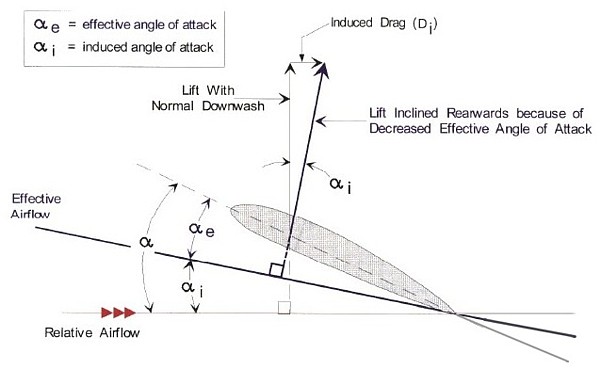1. Summary
Induced angle of attack is technically a mathematical concept. You can't measure it directly via flow sensors [from an isolated wing]. However, it is extremely useful in understanding and predicting the production of induced drag.
Just like Newton's theory of gravity is a mathematical abstraction; but, if it helps you in understanding and predicting outcomes, you might as well accept it as real. Read the following subsections if you want to understand the potential flow aerodynamic modeling a bit better.
EDIT: provided that you have an extremely long wing (and tunnel width) to call 2D section, and provided you have a corresponding high aspect ratio wing to call 3D section, the difference in AOA measured at the same chordwise location should converge to the induced AOA.
2. Lifting-Line
Induced angle of attack comes from an aerodynamic modeling method, called Lifting Line Theory, which approximates the whole wing as one single bound vortex line that changes in vorticity strength across the span. The change in vorticity is shed via trailing vortices across the span.
Since vorticity induces cross-flow, this model predicts net downwash (downward airflow) at every point along this vortex line. And since the wing is just a line, we can neatly separate out the free-stream velocity, which may have a free-stream angle of attack, or geometric angle of attack, against the line, and a downwash velocity that modifies the flow incidence, which we can call induced angle of attack.

Image ref: https://www.researchgate.net/figure/Lifting-Line-Theory-Scheme-Epps-2010_fig1_273450664
This simplified model predicts surprisingly accurate lift for straight, mid to high aspect ratio wing, in low subsonic flight. It also predicts a new kind of drag, called induced drag, which is totally absent in 2D subsonic [potential] flow.
Now, my question is, is any wing a single vortex line? Of course not. It's a model that gives very useful engineering results. The immediate shortcoming of the model is that it doesn't predict the flow field around the wing well, at all. How can it? It's a line!
3. Lifting-Surface
We can do better by approximating the whole wing as a lifting surface (or its cousin vortex-lattice), with the whole surface producing and shedding vorticity. This model is able to predict the flow field near the wing much better, by producing a different value of downwash at every spanwise and chordwise point. In front of the wing, there will be upwash. So if you measure flow incidence in front of the wing, you will measure higher incidence than the free-stream one.

Image ref: Drela, Flight Vehicle Aerodynamics
At this point, you should realize that the induced angle of attack is no more (because there is different downwash at every chordwise point). But for the same high aspect ratio, straight tapered wing, both lifting-line and lifting surface will agree on prediction of lift and induced drag.
So once again, is a wing a flat surface of vorticity? Of course not. Wing has thickness that lifting surface doesn't handle, and nor does it predict boundary layer.





